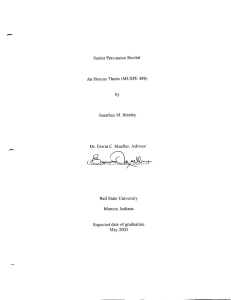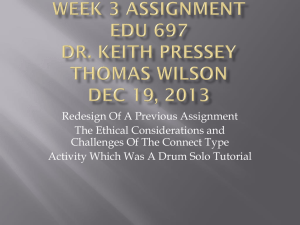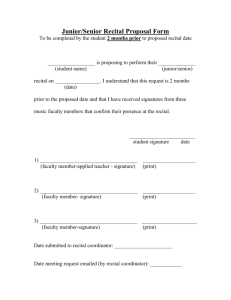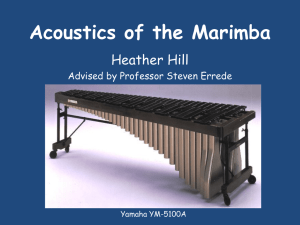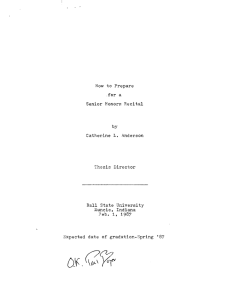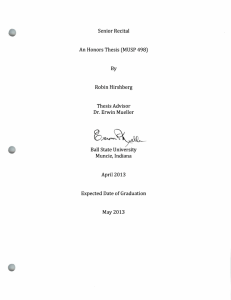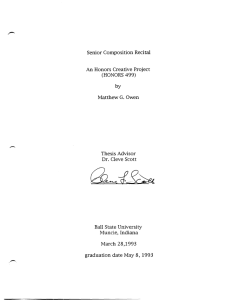-
advertisement
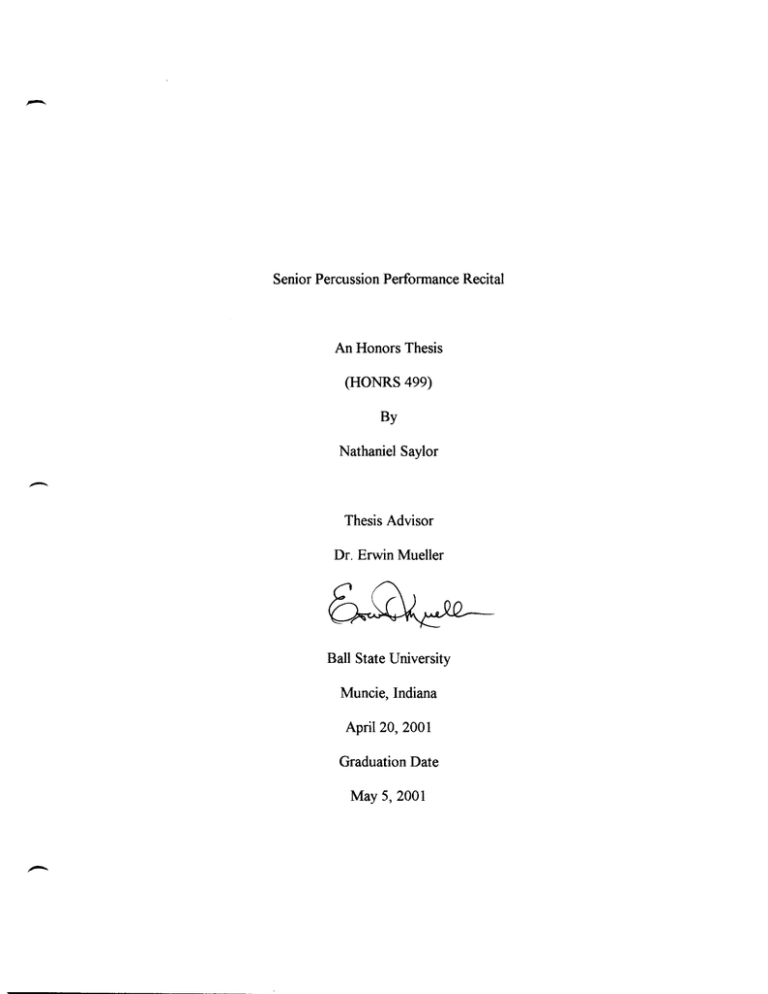
Senior Percussion Performance Recital An Honors Thesis (HONRS 499) By - Nathaniel Saylor Thesis Advisor Dr. Erwin Mueller Ball State University Muncie, Indiana April 20, 2001 Graduation Date May 5,2001 L..D Acknowledgements First and foremost I would like to thank Dr. Erwin Mueller, my thesis advisor, for all his help, insight, and patience. He has been my lesson instructor for the past four years. His willingness to share his knowledge, never ending patience, and passion for music have been an inspiration to me in every aspect of my college career. I would also like to thank Barbara Mueller, Kent Craig, David Bugher, and Travis Beck for the donation of their time and ta1ent in the preparation of this recital. Thank you all for your willingness to assist in this endeavor. There were a number of factors that influenced the final product of my thesis. I chose to give a recital in that I am a performance major. It is only natural that this project reflect the area in which I have put the most effort. After deciding to give a recital, choosing my advisor was merely a technicality. Dr. Mueller has been my lesson instructor for four years, and has helped me more in that time then all other influences combined. W(~ then chose a date and location. The recital will be performed on April 19th at 7:30 PM at the Muncie Center for the Arts. With the project, advisor, and date set it was time to choose a program. The eventual program was picked for different reasons. I wanted to play pieces that would reflect my principal areas of concentration, and highlight my personal strengths. The area that I have worked most in during my time here is the performance of - solo marimba literature performed with four mallets. I also wanted pieces that would give the audience some insight into the development of the marimba as a solo instrument, and to present some of the now standard repertoire. I did not want to dwell entirely in the past, however, so I chose some pieces written in a more contemporary fashion. I chos(: "Concertino" by Creston because it has the distinction of being the first concerto for marimba and is a standard of the literature by any measure. It is also a strong selection because the first and third movements highlight two mallet technique and the second demonstrates a legato style. The snare drum solo I chose, "And the Kitchen Sink," is an advanced rudimental solo. I chose this solo because I have been a member of the drumline of "The Pride of Mid America" for four years, but never performed a solo in that style. The third selection, "Ultimatum 1" was chosen as a more contemporary piece. - This marimba solo, of all the pieces, probably best represents what I have performed in the past. It is however, much more technically demanding than anything I have ever played. I chose "Canaries" because I was interested in the compositional techniques employed by the composer called metric modulation in which the tempo changes by using relationships between already established note values. The final piece on the program is "Marimba SpirituaL" I chose this piece because it is unlike anything I have done in the past. It is a marimba solo, but it is accompanied by three percussionists playing a colorful array of percussive instruments, and even employing their vocal cords. This piece is challenging not only physically, but mentally as well in that it lasts approximately fifteen minutes with no only sparse breaks. As you can see, the decisions about what to program were very well thought out. After e:stablishing a program it was time to get to work. The recital began to take - shape in October oflast year, although the program wasn't entirely set at this time, it was when I began to work on "Marimba Spiritual" and "Ultimatum I." Creston was begun shortly after s(~mester break, which was when I began to seriously work on the other two pieces as well. Every week in my lesson with Dr. Mueller we would work on pieces for the recital. Much of Dr. Mueller's input was based on the musical aspects of the playing as opposed to the technical. He gave me ideas about dynamic shadings and phrases based on his experiences with each piece. Much of the aesthetics of this performance can be attributed to his influence. After these lessons I would spend an average of two to three hours a day in the practice rooms seven days a week trying to achieve the goals we had established in the previous lesson. This program is especially demanding because each piece places different stresses - on the perfomler. The marimba solos all have to be memorized since that is the only way to perform them with accuracy. Not only do the notes need to be memorized and played correctly, but the aesthetics of the music, dynamics and tempo, that put the performer's personal stamp on the piece must be observed. The timpani solo, "Canaries," requires that the performer not only understand metric modulations and play the correct rhythms, but also to strike the timpani in the three different areas. All in all, it took months of very dedicated work to perform this concert that will only last approximately an hour. This recital does not represent just a few months of work, but rather of my entire musical career. Every lesson that I have ever learned, and everything I know about music was utilized in the preparation of this recital. That is not to say that these are the only pieces I could have chosen for this project, but rather that music is a cumulative and ever changing process in which we can relate information we have gathered at all stages of our - development. I could not have chosen a better project to represent my education at Ball State, and I am grateful to have had the opportunity, and Dr. Mueller's support, to share it in fulfillment of this requirement. - Nathaniel Saylor In a Senior Percussion Recital with Barbara Mueller, piano Kent Craig, David Bugher, Travis Beck, percussion Concertino for Marimba and Orchestra...................................... Paul Creston (1930-1985) I. Vigorous II. Calm And the Kitchc~n Sink............................................................................ Edward Freytag Ultimatum I for Solo Marimba ..................................................... N.J. Zivkovic (b. 1962) Intermission Eight Pieces for Timpani .................................................. , ............. Elliott Carter (b. 1908) VII. Canaries Marimba Spiritual.. ......................................................................... Minoru Miki (b. 1930) Nathaniel Saylor is a student of Erwin C. Mueller This recital is presented in partial fulfillment of the requirements for graduation from the Ball State University Honors College April 19th,2001 7:30 PM Muncie Civic Center for the Arts -. - Paul Creston was born in 1906 and had no fonnal musical training except some piano and organ lessons in his youth. His style relied heavily on shifting subdivisions of meter, a technique to be found every where in this particular work. He won a number of awards in his lifetime including a Guggenheim Fellowship and the New York Music Critic's Circle Award. He died in 1985. Conc.~rtino Op.21 is the first major work composed for marimba, and Creston's only piece for the instrument. It was commissioned by Frederique Petrides and written in 1940. It was premiered that year with Ruth Stuber Jeanne as the soloist. Miss Jeanne was a student of Clair Omar Musser and George Hamilton Green. The work is in the traditional thre:e movement fonn of Fast/ Slow/ Fast. Technically it is similar to xylophone rags that were popular at the time, it is the hannonies that makes the work unique. "And The Kitchen Sink" is the culmination of Edward Freytag's The Rudimental Cookbook. Composed in 1993, the solo utilizes almost all of the standard 26 rudiments as well as numerous variations of them. The solo contains a number of different tempo and stylistic changes. Mr. Fn~ytag has a Bachelor of Science in Music Education from the University of Tennessee at Chattanooga and a Master of Music in jazz and studio performance from the University of Tennessee at Knoxville. He currently works as a free- lance percussionist and staffwriter for ROW-LOFF Productions. "Ultimatum 1" is an energetic and virtuosic piece made up of three sections. The first section is full of intense hannonies and is comprised mostly of rolls. The second section is at a blistering tempo and displays the visual aspect of the marimba as a solo instrument. The final section is an explosive "groove" in 14/16. This section requires the perfonner to strike the bars with the head and shaft of the mallet simultaneously creating a "rim shot" e1fect. The composer, Nebjosa Jovan Zivkovic currently resides in Germany, but grew up in Yugoslavia and received his first musical training there. He received his Masters of Composition and Performance in Gennany. He cites these differing influences as key to his compositional style. He has toured in Europe, Japan, Taiwan, Korea, and the United States. He is not only a perfonner, but a teacher as well, giving master classes at over 20 Universities in the U.S. alone. - Elliot Carter studied composition with Clifton Furness, Gustav Holst, and Walter Piston. He was mostly influenced by "modem music" such as Stravinsky, and disliked Mozart and Beethoven. From 1932-1936 he studied with Nadia Boulanger in Paris. He has taught at several universities in the United States. His expertise was not limited to music however, as he taught Greek, philosophy, and math as well. In 1960, he won a Pulitzer Prize for music, and the Sibelius Medal for music. ,- The title of this piece, "Canaries," refers to a dance from the Canary Islands. The solo requires the use of three striking areas on the drum, center, rim, and normal. The piece, like many of Carter's works, uses metric modulation which changes the tempo by utilizing relationships between rhythmic values. Marimba Spiritual was composed in 1983/4. It is meant to depict a period of starvation in Africa occurring at that time. The first half of the piece is a requiem for the victims and the second half is a resurrection. This particular arrangement is dedicated to Keiko Abe, a marimba composer and virtuoso, and features three multi-percussionists as well as solo marimba. The rhythm patterns in the second section are based on the Chichibu tradition from northwest of Tokyo. Minoru Miki was born in Japan in 1930. He graduated from the Tokyo National University of Music as a composition major, and founded Pro Musica Nipponia in 1964. He has spent much of his life promoting the sounds of traditional Japanese instruments, and even inventing one of his own, the 21 string Koto. In 1975 he won the Giraud Opera Prize for his first opera ever. He is recognized the world over not only for his percussion compositions, but for his works in other genres. - Bibliography Articles Kastner, Kathleen. "Creston, Milhaud, and Kurka: An Examination of the Marimba Concerti." Percussive Notes 32.4 (Aug. 1994): 83-87 Toth, Ben. "Uneven Soul: A Conversation with Nebjosa Jovan Zivkovic." Percussive Notes 35.6 (Dec. 1997): 47-49 Dissertations Lang, K.athryn. "Program Notes from a Graduate Recital." Diss. BSU, 1999 Wolff, Greg. "Elliott Carter: Metrical Modulation as Used in 'Canaries' and 'March'." Diss. BSU, 1990 Websites http://www.2u.biglobe.ne.jp/-m-mikilindex_e.html http://www.schirmer.com!composers/creston bio. html
